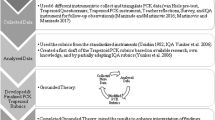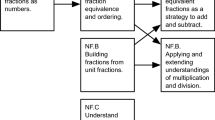Abstract
This paper describes a research project whose major aim was to evaluate first-year teacher education students' understanding of subject matter knowledge in the domain of area measurement. In contrast to many previous approaches to evaluating teacher education students' subject matter knowledge, the approach adopted in this study not only focused on the student teachers' substantive knowledge but also on their knowledge about the nature and discourse of mathematics, their knowledge about mathematics in society and their dispositions towards mathematics. To this end, each student was clinically interviewed whilst engaged on a set of eight tasks that were developed for the study. The development of the tasks was a major component of the study and this is described in detail. The results of the tasks are given and the paper concludes with a discussion of the findings. This discussion focuses primarily on the implications that these results have for preservice mathematics education courses.
Similar content being viewed by others
References
Ball, D. L.: 1990, Teaching mathematics for understanding: What do teachers need to know about subject matter knowledge, in M. M.Kennedy (ed.), Teaching academic subjects to diverse learners, Teachers College Press, New York, pp. 63–83.
Ball, D. L.: 1991, Research on teaching mathematics: Making subject matter part of the equation, in J.Brophy (ed.), Advances in research on teaching: Vol. 2. Teachers' knowledge of subject matter as it relates to their teaching practices, JAI Press, Greenwich, CT, pp. 1–48.
Ball, D. L. and McDiarmid, G. W.: 1989, The subject matter preparation of teachers (Issue Paper 89-4). Michigan State University, National Center for Research on Teacher Education, East Lansing, MI.
Baturo, A. R. and Cooper, T. C.: 1993, Theories of mathematical understanding. (Tech. Rep. No. 5). Queensland University of Technology, Centre for Mathematics and Science Education, Brisbane.
Carpenter, T., Coburn, T. G., Reys, R. E. and Wilson, J. W.: 1981, Results from the First Mathematics Assessment of the National Assessment of Educational Progress, NCTM, Reston, VA.
Del Grande, J.: 1990, Spatial sense, Arithmetic Teacher, February, 14–20.
DeLoache, J. S. and Marzols, D. P.: 1992, When a picture is not worth a thousand words: Young children's understanding of pictures and models, Cognitive Development 7, 317–329.
Douady, R.: 1985, The interplay between different settings, tool-object dialectic in the extension of mathematical ability, Proceeding of PME 9, Noordwijkerhout 2, 33–52.
Erlwanger, S. H.: 1975, Case studies of children's conceptions of mathematics, Journal of Children's Mathematical Behaviour 1(3), 157–283.
Freudenthal, H.: 1983, Didactical phenomology of mathematical structures, Reidel, Dordrecht, Holland.
Grossman, P. L.: 1991, What are we talking about anyway? Subject matter knowledge of secondary English teachers, in J.Brophy (ed.), Advances in research on teaching: Vol. 2. Teachers' knowledge of subject matter as it relates to their teaching practices, JAI Press, Greenwich, CT, pp. 265–304.
Hill, D.: 1988, Misleading illustrations, Research in Science Education 18, 290–297.
Hirstein, J. J.: 1981, The second National Assessment in Mathematics: Area and Volume. Mathematics Teacher 74(9), 704–708.
Kaput, J. J.: 1987, Representation systems and mathematics, in C.Janvier (ed.), Problems of representation in the teaching and learning of mathematics Lawrence Erlbaum, Hillsdale, NJ, pp. 19–26.
Kouba, V. L., Brown, C. A., Carpenter, T. P., Lindquist, M. M., Silver, E. A. and Swafford, J. O.: 1988, Results of the Fourth NAEP Assessment of Mathematics: Measurement, Geometry, Data Interpretation, Attitudes, and Other Topics, Arithmetic Teacher 36(9), 10–16.
Lampert, M.: 1986, Knowing, doing and teaching multiplication, Cognition and Instruction 3, 305–342.
Leinhardt, G.: 1988, Getting to know: Tracing students' mathematical knowledge from intuition to competence, Educational Psychologist 23(2), 119–144.
Leinhardt, G. and Smith, D. A.: 1986, Expertise in mathematics instruction: Subject matter knowledge. Journal of Educational Psychology 77(3), 247–271.
Mayer Committee.: 1992, Employment-related key competencies: A proposal for consultation, Australian Education Council, Melbourne.
McDiarmid, G. W.: 1988, The liberal arts: Will more result in better subject matter understanding, Theory into Practice 29(1), 21–29.
McDiarmid, G. W., Ball, D. L. and Anderson, C. W.: 1990, Why staying one chapter ahead doesn't really work: Subject-specific pedagogy, in M. C.Reynolds (ed.), Knowledge base for the beginning teacher, Pergamon Press, New York, pp. 193–205.
National Research Council.: 1989, Everybody counts: A report to the nation on the future of mathematics education, National Academy Press, Washington, DC.
Nunes, T., Light, P. and Mason, J.: 1993, Tools for thought: The measurement of length and area, Learning and Instruction 3, 39–54.
Piaget, J., Inhelder, B. and Seminska, A.: 1960, The child's conception of geometry, Routledge and Kegan Paul, London.
Romberg, T. A. and Uprichard, A. E.: 1977, The nature of the clinical investigation, Clinical investigation in mathematics education, Research Council for Diagnostic and Prescriptive Mathematics, 1–14.
Roth, K. J. and Anderson, C. W.: 1990, Promoting conceptual change: Learning from science texts, in P.Ramsden (ed.), Improving learning: New perspectives, Routledge and Kegan Paul, London, pp. 126–141.
Speedy, G.: 1989, Discipline review of teacher education in mathematics and science, Australian Government Printer, Canberra, ACT.
Tierney, C., Boyd, C. and Davis, G.: 1990, Prospective primary teachers' conception of area, Proceedings of the Fourteenth Psychology in Mathematics Education Conference, Volume 2, Mexico.
Wheeler, A. and Hill, D.: 1990, Diagram-ese, Science Teacher 57(5), 59–63.
Wilson, S. M.: 1988, Understanding historical understanding: Subject matter knowledge and the teaching of US history, Unpublished doctoral dissertation, Stanford University.
Wineburg, S. S. and Wilson, S. M.: 1988, Models of wisdom in the teaching of history, Phi Delta Kappan 70(1), 50–58.
Woodward, E. and Byrd, F.: 1983, Area: Included topic; neglected concept, School, Science and Mathematics 83(4), 343–346.
Author information
Authors and Affiliations
Rights and permissions
About this article
Cite this article
Baturo, A., Nason, R. Student teachers' subject matter knowledge within the domain of area measurement. Educ Stud Math 31, 235–268 (1996). https://doi.org/10.1007/BF00376322
Issue Date:
DOI: https://doi.org/10.1007/BF00376322




